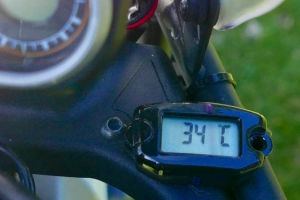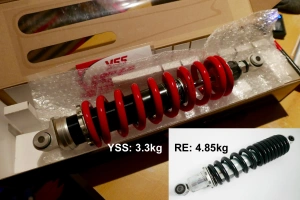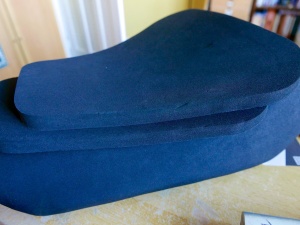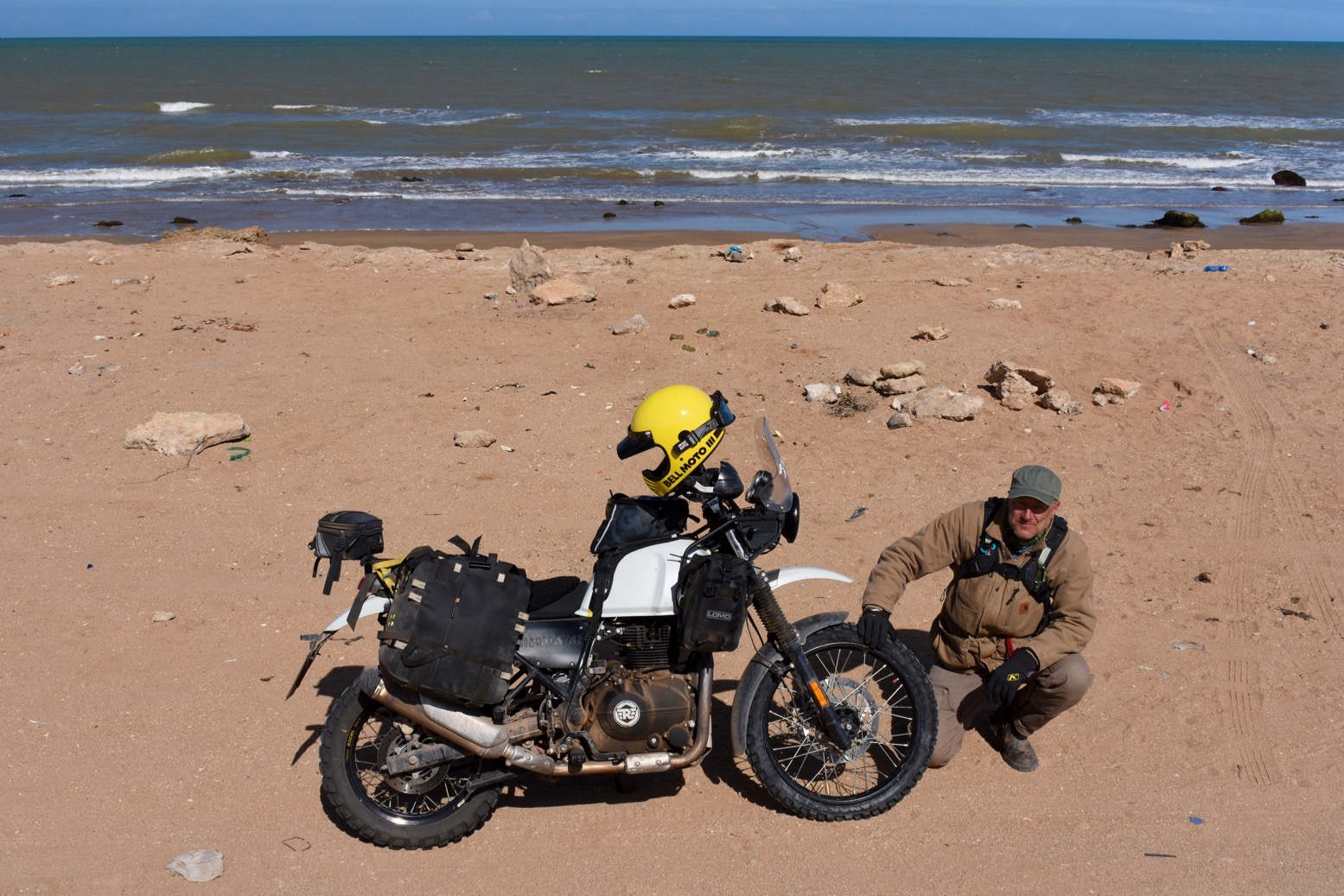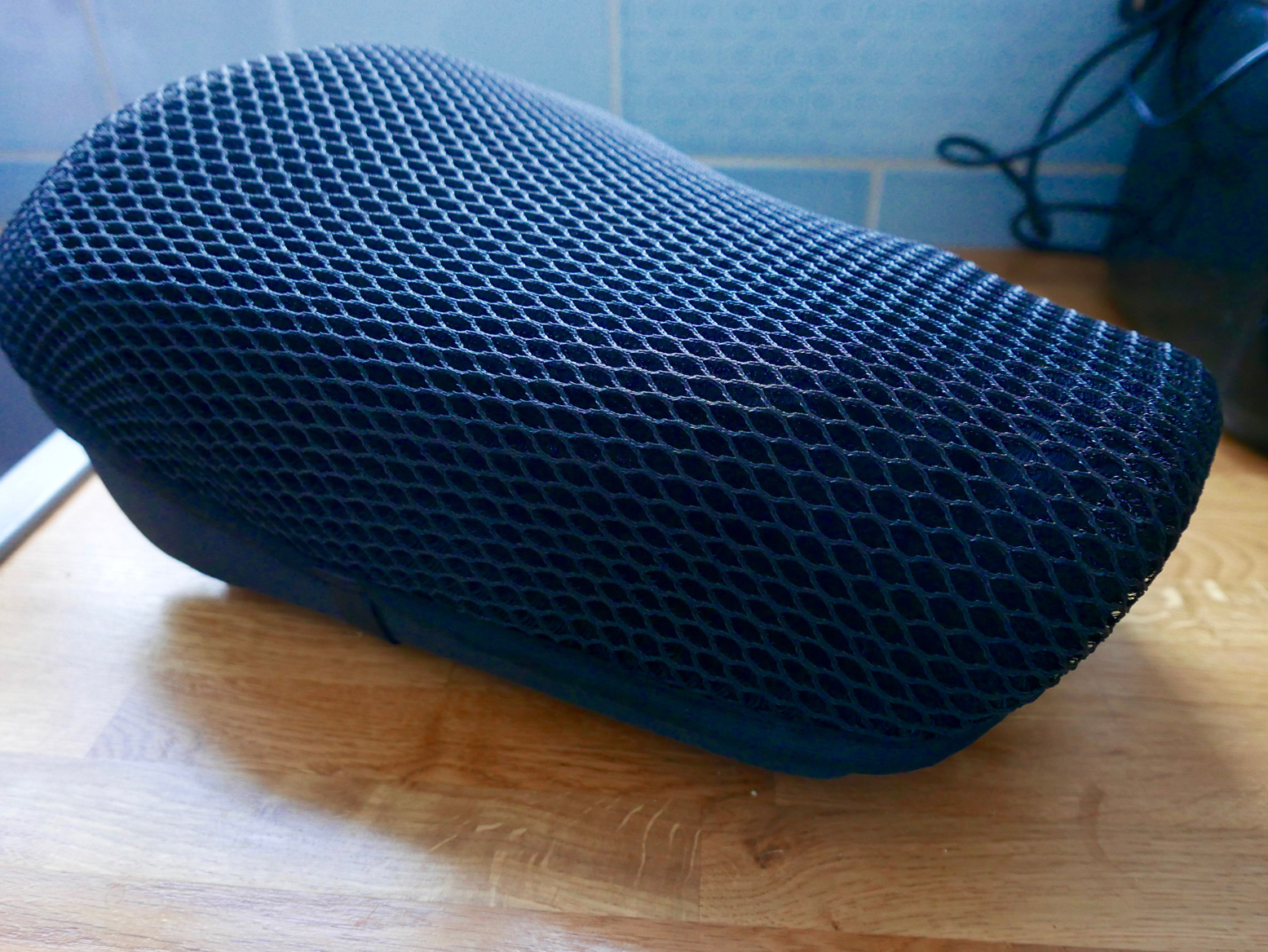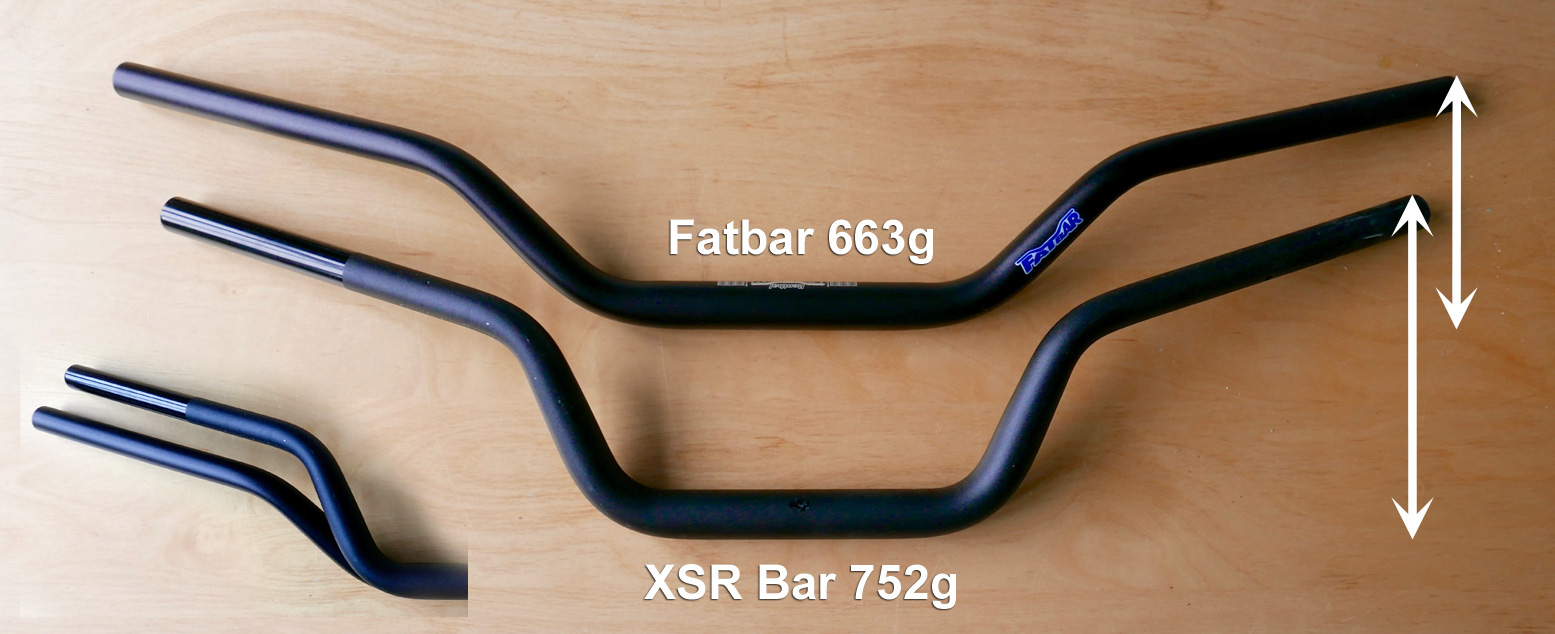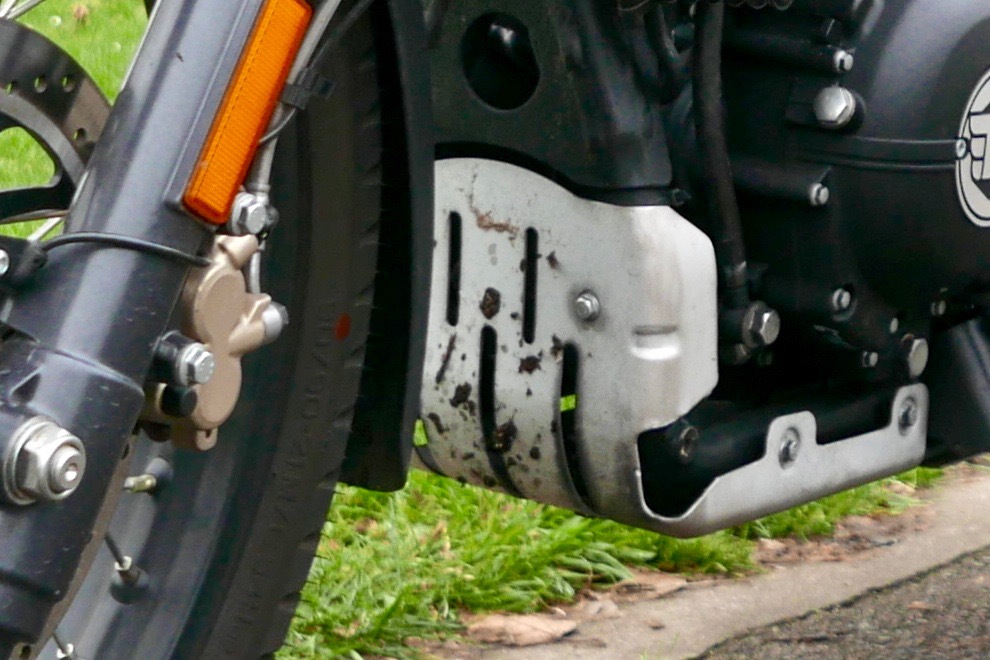Himalayan Index Page
2024 Himalayan 450 preview
Updated January 2024

In a line:
Didn’t miss a beat over a month; no one was more surprised than me.
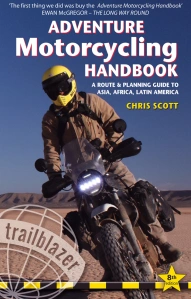
 • At £4000, with the stock equipment it [was] a bargain. (Now £5050).
• At £4000, with the stock equipment it [was] a bargain. (Now £5050).
• Low, 800mm seat – at last a travel bike not limited to tall people
• Enfield build quality stood up to it
• Efi motor pulled smoothly up to 3000m (nearly 10,000′)
• Michelin Anakee Wilds (run tubeless) – great do-it-all tyres
• Low CoG and 21-″ front make it agile on the dirt
• Rear YSS shock showed up the harsh forks
• Yes it’s 190kg, but road and trail, it carries it well (or low)
• Subframe easily sturdy enough for RTW load carrying
• Economy went up and up: averaged 78 mpg (65 US; 27.6kpl; 3.62L/100k)
• 400km range from the 15-litre tank – about 250 miles
 • Valves need checking every 3000 miles – not practical
• Valves need checking every 3000 miles – not practical
• Weak front brake on the road (sintered pads are a fix)
• As a result, front ABS is a bit docile
• Stock seat foam way too soft for my bulk
• Tubliss core failed on the front; replaced with inner tube
• Centre stand hangs low – but can be raised
• Small digit dash data hard to read at a glance
• Compass always out – a gimmick
• Head bearings notchy at 4000 miles, despite regressing @ 1200 (replaced on warranty @ 5000)

Review
Following a test ride, I bought a used Himalayan with just under 1000 miles. And following the make-over detailed here (summarised in the image below) I picked it up in southern Spain with 1300 miles on the clock. So, like many of my crudely adapted project bikes, I’d barely ridden the thing or tested the modifications. With a Royal Enfield this did feel a bit more of a gamble than usual and, on collection near Malaga I was all prepared for the worst.
Far from it. The Him started on the button, ticked-over like a diesel, and after the ferry crossing and fighting the usual headwind gale down the Atlantic motorway, I arrived at a cushy hilltop lodge near Asilah feeling moderately hopeful, while still braced for a kick in the nuts somewhere down the road.
Riding an untried, near-new machine, saddled with Enfield’s possibly outdated reputation for reliability led to stressful days, waiting for something to play up, either with the bike or with my mods. I had the same feeling with BMW’s XCountry years ago. But riding my first piste: the lovely Assif Melloul gorge route out of Anergui inspired confidence. The low-slung weight and chuggy motor made this a great trail bike!

Engine and transmission
Much is made of the 410LS’s meagre 24hp (or even 22) because we’re so used to bikes delivering over 100hp per litre. Don’t forget Honda’s ill-concieved CRF450L makes about the same. It’s when you combine 24hp with the strapping 190-kilo wet weight you’d think it can’t possibly work. Yet it does – and in a way that you won’t find on a similar powered and much lighter 250 trail bike like the WR250R, KLX250S, CRF250L or 300L which I’ve also used, as well as a 310GS. I prefered riding my REH to all of them.
It must be down to the way the long-stroke, low compression, two-valve motor delivers it’s modest power, like something from the apogee of Brit biking half a century ago, but without a millstone for a flywheel, it revs more freely. The Himalayan may have the power of a CRF250L, but it has the torque of an XR400: 32Nm at 4250rpm (1150 lower than the XR). Combined with counter balancer and unexpected refinement, despite wide gearing it’s a very satisfying bike to ride. It won’t hurl you from bend to bend, it just chugs along steadily but without the sensation that you’re missing out or grossly under powered. The key is to maintain smooth momentum which is very much the riding style I aspire to. It’s an easy bike to enjoy on the empty roads and even emptier trails of southern Morocco. Duelling with congested traffic or tackling busy alpine passes may not be such fun.
Until the end of my trip – by which time the valves were technically well overdue for adjustment – it started on the button without the ‘choke’, ticked over once warmed up (probably needs adjustment too) and fuelled cleanly up to 5000rpm and nearly 10,000 feet (3000m).
A lot of it must be down to accepting the Himalayan for what it is, but there was never a moment on my ride when I thought ‘FFS! I wish this thing had more poke’. I tried some super grade fuel in Morocco but didn’t notice the difference that some claim (I know in the US fuel octane varies widely). However, once back on Spanish fuel, it did seem faster and smoother, or maybe I was just rushing for the finish line.
One thing the Trail Tech temperature sensor did highlight was how hot the air-cooled engine runs – up to 240°C at higher revs with a load on. Note I say ‘hot’, not over-heating. On my bike it’s reading from the spark plug, about as hot as it gets in there. Running down hill it might drop to 160°C or so. Either way, especially with an air-cooled motor, it’s good to know how hard the engine is working and when it may be time to back off.
Oil consumption was zero up to a pre-emptive oil change at 3000 miles. Straight 50W Moroccan was all they had (a bit thicker; better for hot weather) and I had the feeling consumption increased briefly after that, maybe 200ml in 2000 miles, but then it stopped.
The gearbox is a lot less clunky than some. Originally, I thought first gear would be too tall off road (a common complaint I have) but, helped by the low-down torque, it’s well matched to the Himalayan’s modest trail biking abilities which are governed mainly by its weight. One time in deep soft sand, the gearing was too tall to move the bike forward – the chain jumped on the front sprocket instead (see below).
The chain had a hard time in Morocco: conditions too gritty to lube most of the time. On longer road stretches I hand-lubed with a toothbrush from small bottle of Tutoro oil. As a result I adjusted it three times in 4000 miles – more than normal, even for a stock chain. Again, you have to assume the stock chain was chosen for its price, not quality, but with a bit more care and lube it should last 8000 miles.
Suspension
Normally the suspension is where a budget bike shows its limits once pushed on rough roads and trails, with heavy loads. Plus I tend to leave my tyres at road pressures unless absolutely necessary, so as a result off-road the my suspension can feel harsher than it could be.
On the rear there’s only preload adjustment and nothing on the front, but the Himalayan surprised me with firm suspension. Before I realised this, I’d fitted some inexpensive fork preload caps, (set at zero), and a YSS shock that had 1cm of length adjustment and 35 clicks of rebound damping. I had the YSS fitted on the settings out of the box (more here) which worked fine once loaded up and on the dirt. At one point in Morocco I screwed the rebound in 4 clicks (more rebound?) but can’t say I noticed any difference.
Overall, I suspect the stock shock (inset above) would have been OK, but you have to assume the YSS is an improvement because there’s more adjustment and it’s red. It certainly felt better than a twice-as-expensive Wilbers on the XSR last year. Over the trip it loosened up a bit and bottomed out maybe once.
If anything the front forks are now shown up by the YSS. YSS do offer a fork kit but in the UK it’s £330 (though it seems you can buy springs plus the emulators for half that). Bottom line: no great need to meddle with the stock suspension for normal riding.

Economy
It seems that even at 1300 miles the air-cooled REH was still running in. As I added the miles the economy improved, eventually averaging 78.7mpg (27.8kpl; 65US). With the 15-litre tank that’s an ideal range of just over 400km. Riding with some 310GSs for a week, my mpg was near identical to the more powerful and lighter BMWs. The gauge on the tank is pessimistic and the warning light plus a trip reset comes on with a good 100km left. Hot, cold, high, low, the fueling itself was glitch-free. Fuel consumption data here.

Comfort
Thanks to a counter-balanced and non-ginormous capacity, the REH is very smooth for a single. I did feel some tingling in my right hand after hours at the bars which could have been from over-gripping a heavy throttle. I’d have used my throttle handrest had I remembered it.
One of the best things about the Himalayan is the low seat of 800mm or 31.5 inches. At 6′ 1″, it’s actually a bit too low for me, especially once my mass sinks down through the soft foam, but at last there’s a travel bike which isn’t limited to tall people, while still having useful ground clearance. It never scraped out on the dirt
I needed more height with firmer foam, inexpensively achieved with a couple of 20mm neoprene slabs under a Cool Cover. It enabled 500-km days with few stops, but on rough tracks still gave soreness, probably because I wasn’t standing up or letting the tyres down enough. I also thought the seat could do with levelling out to stop me sliding forward on the slippery, aerated Cool Cover.
My seat bodge was not a night-and-day transformation, but by the end of my trip it didn’t cause any discomfort over long days on the road. I’m less convinced now that I need to improve it some more.
The 50mm bar risers managed to not snag the screen on full lock and nearly reduced my stooping when standing up – another inch would have done it. I might have cured that stoop by removing the footrest rubbers, but to be honest I liked the comfort when standing (in ordinary slip-on Blunnies). Otherwise, for wet conditions, consider fitting wider footrests if you’re off-roading. I hear DR650 pegs nearly fit.

Some say it will clock 80 but I set myself a self-imposed cruising limit of around 65mph (where possible). At this speed the screen did a pretty good job, even with my wind-catching Bell Moto III helmet. Others claim the mirrors create turbulence and are better moved or changed. I suppose this is possible but that complaint is a new one on me. Let’s face it: it’s a motorbike out in the wind, not a space capsule. Some turbulence will be evident.
On the dirt
The Him took to the dirt so naturally, I didn’t even notice it at first. The key attributes must be the Michelin tyres, low seat and firm suspension. The 21-inch front wheel must help too, as does the torquey motor, getting round the wide gearing. And the otherwise ordinary brakes are just right on the dirt.
The Him is a plodder, but then so am I. You won’t be pulling wheelies, launching off jumps or bouncing off berms. For that the bike is just too heavy and low-powered. It’s a travel bike, not a dirt bike and in all the miles I never ever had a sketchy moment on the dirt, nor wished the bike was something else.
I reached the Himalayan’s limit in the sandy gorge on Route MW6/7 in Western Sahara – same place I’d struggled with the WR two years earlier. This time I traced a better route along the valley but the flooded waterhole was now a dry mass of deep sandy ruts in which the Himalayan would bog down for sure. I aired down, pushed around the side in first gear, but stopped once the chain jumped on the front sprocket from the strain: the torque had got the better of the weight, tall gearing and deep sand. The Himalayan doesn’t have the agility or power to handle deep soft sand – for that you want an unloaded KTM 450.
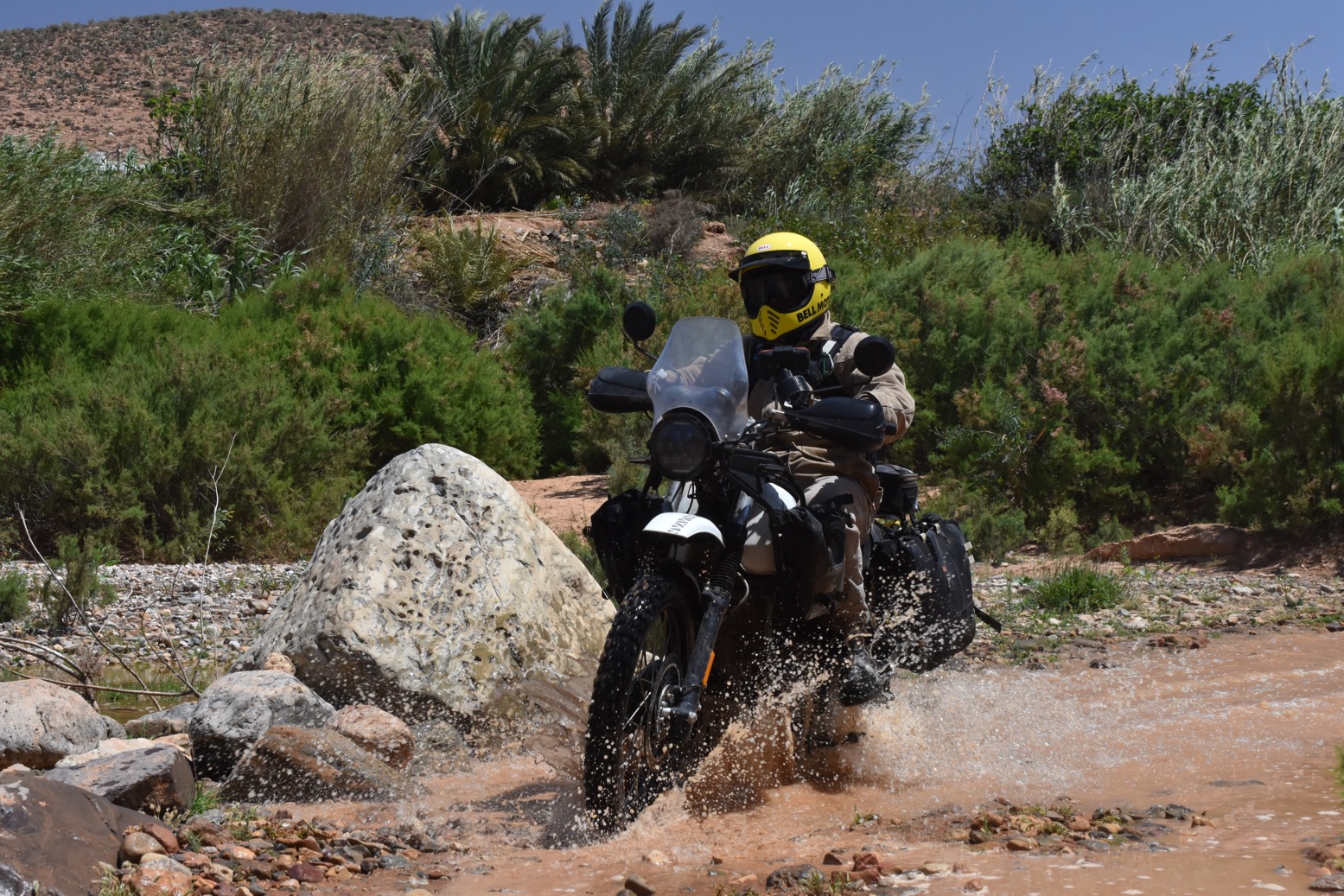
Durability and problems
It’s a short list. Apart from what’s below, nothing broke or even came loose, but I’ve not seen the bike since I left it at Malaga. A closer inspection may reveal more.
Stock bike
• Head bearings got notchy by 4000 miles, despite regreasing
• Chain needed adjustment every 1000 miles
• Exhaust guards dented
My mods
• Tubliss core leaked around valve stem, then packed up
• Michelin TPMS packed up – twice
Summary
The Himalayan is a unique all-road travel bike, one that not only looks fit for the job as many adv bikes do – but that’s actually equipped for it and performs well, too. You might not think 24hp and 190 kilos (420 lbs) adds up, and for some it won’t. But for your £4000 or $4500 you get a lot of kit that’s no found on similar bikes. Don’t dismiss it as a shoddily assembled Asian cheapie, or anything to do with the Bullets. The bike has caught on, and in western markets the demand for the BS4 has outstripped importers’ expectations. If you’re curious like I was, try one. You might also be surprised.



